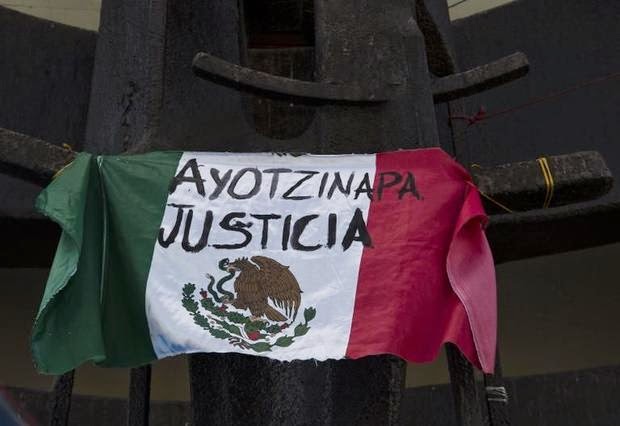By Javier Flores
Source La Jornada
These days two distinct forms of social reaction to the disappearance of students from the Rural Normal School of Ayotzinapa are being expressed.One of them is a form of spontaneous protest that shows the great dissatisfaction that exists among broad sectors of Mexican society. According to various scenarios I've heard from very qualified people on these issues, social mobilizations expressed exasperation at the violence, corruption and impunity, which unfortunately have characterized our country for many years. The trigger was the murder of six people, including three young normal schools students, and the disappearance of 43 classmates.

Some of these violent expressions have taken place in various states, particularly in Oaxaca and especially in Guerrero, a state in which there are many reasons that may explain this, including the very low socioeconomic status of most of the population and that it is the home of the youth who were killed and of the families of the missing students. In addition to several peaceful actions, there have been attacks in that state on the property of political parties and municipal and state governments, as well as looting of shops.
The violence in Mexico City, in my opinion, is different, because the groups who now practice it were present before the events in Iguala [at least from the day of Enrique Peña Nieto`s inauguration as President, Dec. 1, 2012]. They have made the target of their attacks one of the most important institution of higher education and research in the country: the National Autonomous University of Mexico (UNAM),.. In other words, the groups using violence here have a different agenda.
On Oct. 30, outside the main gate of University City, a rescue vehicle was burned by people who had their faces covered. On Nov. 5, hooded persons set fire to a unit of the Metrobus and the station of this public transport system in front of UNAM. On Saturday, Nov. 15, using as cover a peaceful demonstration in defense of university autonomy (after Mexico City police entered the campus on and shot two students, not critically, at a rally), a group of people, also with their faces covered, tried to enter the Rectory Tower [administration building] and take it by force. They failed, but at the time of the writing of these lines, they are blocking the main entrance of that historic building.
There is another distinction to be made. Outrage over events in Guerrero has raised a genuine growing student movement in higher education institutions across the country. In Mexico City, UNAM students are among the most visible and participatory groups. They demonstrate with uncovered faces, demanding the safe return of the Ayotzinapa students. In the demonstrations, groups from UNAM and other schools have formed walls to avoid being infiltrated by violent groups. The student movement that is being born does not fit with the practices of groups mistakenly called "anarchists".
MV Note: On Dec. 1, 2012, during protests in the Historic Center of Mexico City, against the inauguration of Enrique Peña Nieto as President, some small groups of self-identified "anarchists" acted with violence, throwing Molotov cocktails at police, breaking windows of businesses and damaging public property. The city police did not act to stop them, but later arrested peaceful protesters and bystanders. These "anarchists" have violently disrupted other subsequent peaceful demonstrations.
In the spring of 2013, students from some of the high schools within the UNAM system seized the main campus Rectory in protest over administrative changes in their schools, A hard core of "anarchists" maintained this seizure until, in the face of university warnings, they finally left. No government agency or journalist has clarified who these people are. Some anarchist organizations have made pùblic statements denying any connection with the violent protests, while also announcing "a winter of discontent" , actions undermine the government. The clearest demonstrations of the separation between the university students and the groups made up of people who mostly cover their faces was the valiant defense made by UNAM students at their peaceful demonstration when confronted by students who wanted to make use of the mobilization on Sunday to try to take possession of the Rectory Tower. Thus, the anonymous people who use violence act behind the back of the largest student movement that has emerged in recent years.
Regarding Sunday's march there is much to say. It was prompted by the attack that occurred the day before when a Federal District (Mexico City) policeman fired a gun inside the UNAM campus, injuring at least one person. The offending agent was there accompanied by an officer of the university who improperly authorized it. This may have been the result of the foolishness of a minor official, or an act of provocation.
In either case, it could have been fatal and so it quickly provoked a justified reaction from the university students, who carried out their march the next day, as well as by the rector (president), Jose Narro Robles, who declared forcefully that any (city or federal) police presence in UNAM was undesirable. Nevertheless, the masked groups tried taking over the Rectory and demanding the resignation of the rector.
So, there are two types of demonstrations. Unfortunately, those who covers their faces and act wtih with violence intentionally intend to discredit a student movement that is developing, in addition to damaging UNAM. Where do they come from? We don't yet know. Their actions may be the result of desperation and the lack of effective channels for democratic participation. Or they may be the tool of a group located in some sphere of political and economic power.
